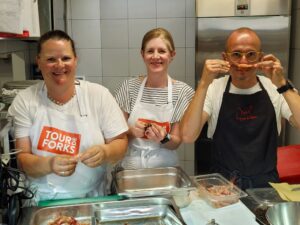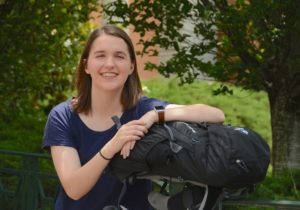
Girls That Roam loves the color purple, so it was a treat to stumble upon Ali’i Kula Lavender Farm
It was a wonderful unexpected surprise when my girlfriend and I accidentally discovered the Ali’i Kula Lavender Farm on Maui.
We arrived early at O’o Farm for our hands-on-farm experience picking the food that would be prepared into a gourmet lunch by the farm’s chef. Since we were early, the women on the phone suggested that Super G and I visit Ali’i Kula Lavender Farm (1100 Waipoli Road, Kula; 808-878-3004; AliiKulaLavender.com) which is right around the bend from O’o Farm.
So, we turned our car out of the driveway and climbed up the mountainside a bit further to discover fields of purple overlooking Maui and the Pacific Ocean.
We couldn’t believe our eyes. It was a lavender lover’s heaven. It was beautiful. We parked and walked through the entrance into the shop that denoted the beginning of the pathways leading around the farm that stretched out over the side of Haleakalā, Maui’s dormant volcano.
I picked up a map for a treasure hunt and was tempted to follow the clues, but we didn’t have time. So, Super G and I decided to have a cup of lavender infused hot chocolate and sit out on the veranda overlooking the farm watching people as they wandered through the labyrinth stopping to smell the fragrant violet flowers.
Royal Connections
In 1998, the late Ali’i Chang, a native Hawaiian farmer, was searching for another drought-friendly plant to add to his Protaia crop, South Africa’s official flower, the original flower that was grown and harvested on the land. By sheer luck a friend gave him a sprig of lavender. He planted it and Ali’i discovered that lavender loved Haleakalā and Ali’i Kula Lavender Farm was born. The farm is now home to more than 55,000 lavender plants covering more than 13½ acres, says Lani Weigert, CEO and president of Ali’i Kula Lavender.
“He actually really felt that the lavender found him in a way,” says Lani, 56.
Lavender originally was brought to Hawaii by the royal family, who traveled all over the world, in the 1800s followed by missionaries brining the purple plant in the early 1900s. Queen Lili’uokalani planted sprigs of lavender in what has become known as Queen Emma’s Garden, or simply the queen’s garden, in Honolulu, Oahu across from Ilona Palace where the queen used to live at Washington Place, where it still grows. Hawaiians loved the plant so much that songs were written about it.
“He really felt that he was taking care of a royal plant, [that] it had finally come back home to us in Maui,” says Lani.

Lani discovered the farm when she happened to go with a friend, at the time it wasn’t open to the public, to pick up a lavender wreath.
“It was one of those serendipitous type [of] things,” continues Lani about her chance meeting with Ali’i on the farm.
Ali’i and Lani began walking around the farm, which was only three acres at the time, chatting, when she suddenly turned to him and says, “Oh, I think that I’m supposed to be here.”
Ali’i replies, “He doesn’t know why I took so long,” she says.
At the time, Lani had more than 30 years experience in marketing and travel. In 2002, she went to work with Ali’i handling the marketing and tourism of the farm until she took it over after he passed in 2011.
“There was a sense of kinship between us as if we already knew each other for a long time,” says Lani.
The two laughed. A month later Lani opened up the farm to the public inviting 300 of the community’s elders to visit the farm that first year and she worked with local business owners enticing them to make products using lavender from the farm to sell in the shop and distribute to other markets.
Lavender Lover’s Heaven
Lavender isn’t just a pretty smelling flower. The herb can be used for many things from bug repellant (except for bees) to healing to being used in savory dishes.
“We could actually keep creating stuff every single day and not stop,” says Lani. “It’s that versatile. Lavender is a real wonder herb.”
Creating stuff from lavender is what they do. The farm gets anywhere from 20 to 60 jars of lavender honey made from the bee hives on the property that sell like hotcakes within a week, says Lani.
There are also 100 olive trees, three different Tuscany varietals, brought to Maui from Santa Cruz, California on the farm. She plans on combining the olive oil and lavender to make lavender oil.

Today, there are an estimated 25 different business partners across Hawai’i that create more than 75 different and unique high-quality locally made lavender products for the lavender farm, says Lani, pointing out that the farm didn’t have any money for advertising or marketing at the time.
“We were able to offer a very high-quality product that was made in Hawaii to our customers,” says Lani, who is eyeing a variety of markets within the US and abroad to sell Ali’i Kula Lavender Farm’s products.
Guests can also make lavender products for themselves at any one of the workshops offered.
Word spread quickly and by the second year 3,000 visitors came to the Ali’i Kula Lavender Farm, which is open year-round.
While the farm doesn’t close for any season, the best time to go is during the summer. That’s when 45 varieties of lavender are in bloom. During other times of the year guests only experience about seven varieties of lavender in bloom.
Guests can enjoy one of the five walking tours or choose to take one of two cart tours of the farm daily or join in on the self-guided treasure hunt starting at the gift shop and café and following clues around the farm. Gathering all of the clues earns guests a lavender shortbread cookie at the end.
There are also three ideal locations to host weddings on the farm that overlook the fields of lavender out onto the Pacific Ocean. Unfortunately, there isn’t lodging available on the farm.
“He really loved sharing the beauty of the farm with everyone,” says Lani about Ali’I who let anyone come to see the farm for free. “He just so enjoyed being with people.”
Aloha
You won’t see bus loads of people heading to the farm. It’s only accessible by car. It’s been a policy of the farm to be grounded in the value center of Aloha.
“For many people Aloha means many different things, but for us Aloha means love, friendship, stewardship and responsibility,” says Lani, pointing out that the farm is eco-friendly and self-sustaining while giving back to the Hawaiian community.
“We found that the more we help the community the more abundance we had coming our way,” Lani adds.
Part of Aloha is respecting the earth and your neighbors. It’s a drive to get up to the farm, “but not a treacherous one,” says Lani and Girls That Roam attests to.
Get lavender fever at Ali’i Kula Lavender Farm, 9 a.m. – 4 p.m. at 1100 Waipoli Road, Kula. Admission: $3. Walking Tour: $12 (daily 9:30 a.m., 10:30 a.m., 11:30 a.m., 1 p.m. and 2:30 p.m). Cart Tours: $25 (daily 10:30 a.m. – 2 p.m.). Treasure Hunt: Free (daily 9 a.m. – 4 p.m.). For more information, contact 808-878-3004 or visit: AliiKulaLavender.com.
To book your Maui vacation, contact Heather Cassell at Girls That Roam Travel at Travel Advisors of Los Gatos at 408-354-6531at or .
To contract an original article, purchase reprints or become a media partner, contact .







